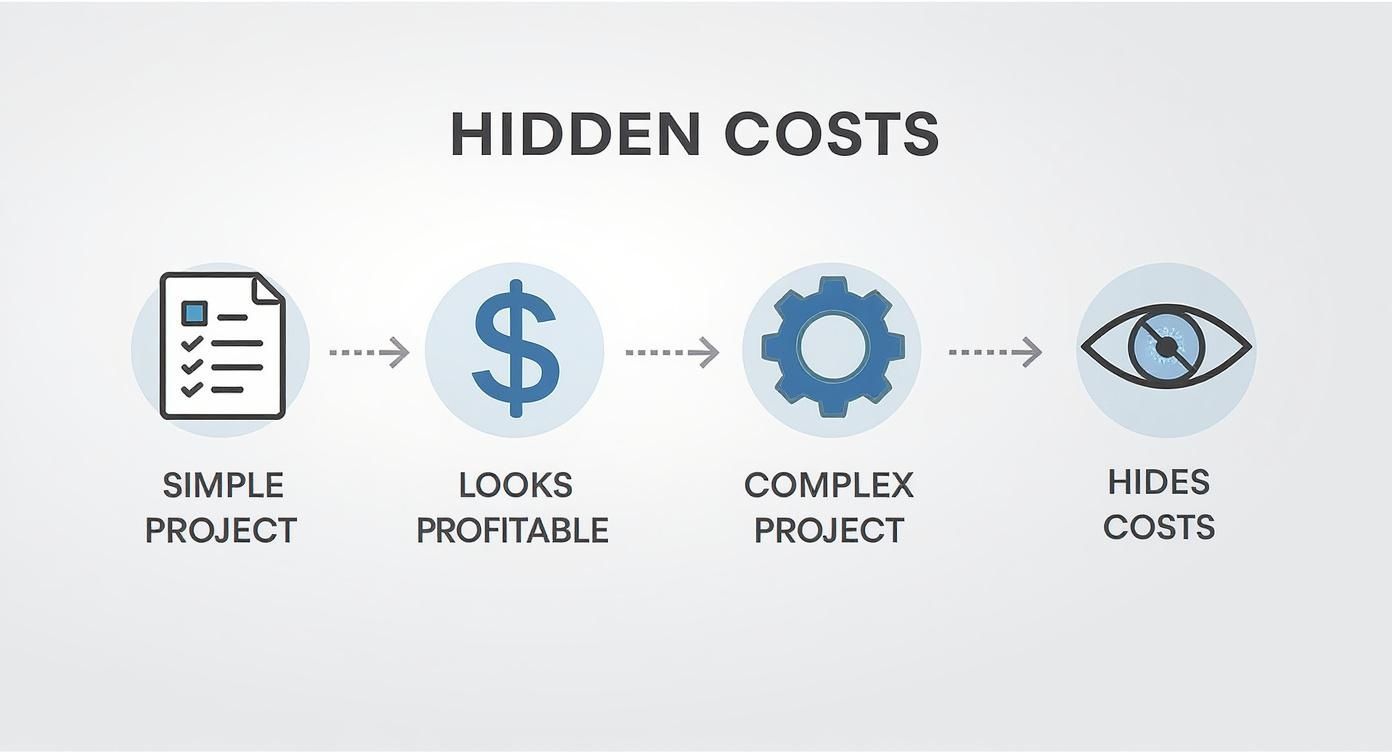Let’s get right to it: What is activity based costing (ABC)?
Think of it as a precision tool for figuring out where your agency's money really goes. Instead of spreading overhead costs evenly across all your projects—like spreading butter on toast—ABC meticulously assigns those costs to the specific projects and clients that actually use the resources.
A Clearer Path to Profitability
The old-school, traditional costing methods can seriously muddy the waters. They often allocate overhead—things like rent, software licenses, and admin salaries—using a single, blunt metric like total labor hours. This makes a simple, low-maintenance client look just as expensive to serve as a complex, high-touch one. We know that's not true.
Activity based costing completely flips that model. It starts by identifying the specific activities that drive your indirect costs, then ties those costs directly to the services that depend on them.
By connecting costs to the activities that cause them, ABC provides a far more accurate picture of project and client profitability. It moves you from financial guesswork to strategic, data-driven decision-making.
This method is built on solid accounting principles. Before you dive in, having a good handle on basic accounting for small business is a huge help, since ABC is really a more detailed extension of those core concepts.
Why This Matters for Your Agency
For any service-based business, knowing your true cost of delivery is everything. With ABC, you can finally see which activities gobble up the most resources and which clients are your actual profit centers.
Imagine getting clear answers to questions like:
- Client Onboarding: How much does setting up a new client really cost when you factor in all the administrative and project management time?
- Design Revisions: Are certain projects secretly eroding their own margins by demanding endless rounds of design and review?
- Reporting and Analytics: What's the real overhead cost of building and presenting client reports every single month?
Answering these questions isn't possible with guesswork; it demands precise data. This is where effective time tracking for agencies becomes absolutely essential, providing the raw data needed to make an ABC system work. It’s what turns a complex accounting theory into a practical, powerful tool for growth.
To really get why a method like activity based costing is a game-changer, you have to understand the broken system it’s meant to replace. The truth is, traditional costing methods often paint a misleading picture of your agency's finances, nudging you toward some pretty questionable business decisions.
These old-school systems grab a single, broad overhead rate—think direct labor hours—and slap it across every project, no questions asked. It seems simple on the surface, maybe even fair. But in reality, it completely warps your financial view. It makes some projects look like cash cows when they’re barely breaking even, while unfairly punishing the straightforward ones.
The Tale of Two Agency Projects
Let's say your agency is working on two website projects, and you’re billing $20,000 for each.
-
Project A: The Simple Template. This one is a breeze. It’s a clean build using a template you’ve used a dozen times. The client is happy with minimal hand-holding, there are hardly any revisions, and your project manager barely has to check in.
-
Project B: The Complex Custom Build. This project is the complete opposite—a total beast. It’s bogged down with endless client strategy sessions, multiple design concepts that keep getting reworked, and constant back-and-forth that has your project management team pulling their hair out.
With a traditional costing model, both projects get hit with a similar slice of overhead, probably tied to the designers' and developers' hours. So, on paper? They look equally profitable. But you and I both know that’s not the real story. Project B secretly devoured a massive amount of your agency’s most valuable (and expensive) indirect resources: your project managers, account execs, and support staff.
Traditional costing treats all projects as if they consume overhead resources at the exact same rate. This flawed assumption masks the true cost drivers, making it impossible to know which clients and projects are actually fueling your growth.
This is the exact problem that activity based costing was designed to solve. While it’s been a staple in big manufacturing firms for years, its principles are absolutely critical for service businesses. In fact, one study found that nearly 22% of companies across various industries have already adopted ABC, with the bigger, more complex organizations leading the way. If you want to dive deeper, you can review the full study about ABC adoption rates here. This isn't just a niche accounting trick; it's a clear shift toward getting a more honest look at your numbers and moving away from methods that hide the truth.
How Activity Based Costing Actually Works
To really get what activity based costing is all about, you have to move past the textbook definitions and see how it works in the real world. At its heart, ABC is just a logical way to trace your overhead costs back to where they came from, giving you a super clear picture of where your money and resources are actually going. It's less about complicated accounting and more about connecting the dots between your expenses and your output.
The whole process breaks down into a few straightforward stages. You start by figuring out the basic activities that eat up your agency's resources, and you end by assigning those costs to the specific projects or clients who actually used them.
Identifying Your Core Activities
First things first, you need to pinpoint the key operational activities that drive your indirect costs. We're not talking about high-level departments here; we're talking about the distinct processes your team carries out every single day. Think about the actions that chew up time and resources but aren't directly billable tasks.
For a creative agency, this might look something like:
- Client Onboarding: All the admin and setup work needed to get a new partnership off the ground.
- Project Management: The hours spent on planning, coordinating, and doing internal check-ins.
- Design Revisions: That whole back-and-forth process of tweaking creative work based on client feedback.
- Campaign Reporting: The legwork involved in pulling data, building dashboards, and presenting results.
Once you’ve got your list, you group the related overhead costs—like salaries for your non-billable folks, software licenses, and office rent—into what are called activity cost pools for each of these core functions.
Pinpointing the Cost Drivers
Next up, for each of those activity pools, you have to identify its unique cost driver. This is the specific metric that makes the cost of an activity go up or down. It's the "why" behind the expense. A cost driver is simply the unit of measure that best reflects how much of an activity a particular project is consuming.
A cost driver is the critical link that connects your overhead costs to your final output. Choosing the right driver ensures your cost allocation is accurate and meaningful.
For example, the cost driver for your "Client Onboarding" pool might be the number of new clients. For "Design Revisions," it could be the number of revision rounds. This step is huge because it dictates how costs get spread out fairly. Plus, tracking these metrics is closely tied to understanding how efficient your team is, which is a big part of when you learn more about how to calculate utilization rate for your staff.
This infographic really shows how old-school costing methods can hide the true cost of complex projects by totally ignoring these hidden activities.
As you can see, a project that looks profitable on paper can easily be a money pit once you account for all the specific activities it actually consumes.
Allocating Costs Accurately
The final step is where the math happens. You'll figure out a rate for each cost driver by dividing the total cost in each activity pool by the total volume of its driver. Let's say your total Project Management cost pool is $100,000 and your team managed 2,000 total project tasks. Your cost driver rate would be $50 per task.
Armed with that rate, you can now assign overhead costs with precision. If a client's project involved 40 management tasks, you'd allocate $2,000 (40 tasks x $50) of your project management overhead directly to that project. This is the moment a fuzzy overhead number turns into a sharp, defensible cost you can actually stand behind.
Unlocking Your Agency’s Financial Health with ABC
Adopting activity based costing is way more than a simple accounting switch. It’s a fundamental shift in how you see your agency’s entire financial engine. When you move past old-school costing methods, you get a powerful new lens to see what's really profitable, leading to smarter decisions that protect your bottom line and set you up for real growth.
The first big win? You can finally create accurate pricing and quotes. When you understand the precise overhead cost of delivering a specific service—from endless client check-ins to those extra rounds of creative revisions—you can price your work with total confidence. No more guesswork. You're using real data to build every proposal on a solid foundation of profitability.
Achieve True Profitability Analysis
With this newfound clarity, you can perform a profitability analysis that was impossible before. You’ll finally see which clients, projects, or even service lines are your true money-makers and which ones are quietly sucking your resources dry.
Imagine discovering that a long-term, “loyal” client is actually costing you money because they demand a ton of non-billable project management and admin support. ABC brings these hidden truths to light. This allows you to either restructure the relationship or, better yet, focus your energy on clients who genuinely boost your financial health.
By illuminating the true cost of every activity, activity based costing empowers agencies to stop subsidizing unprofitable work and start maximizing high-value engagements.
This level of insight is a huge strategic advantage. Yet, surprisingly, not everyone is on board. While it’s more common in developed economies, some studies show a significant lag in adoption elsewhere. For example, research from 2010 found that only 9.3% of corporations in Cameroon had adopted ABC, though those who did reported high satisfaction. This highlights a massive opportunity for forward-thinking agencies to get ahead of the curve. Discover more insights about global ABC adoption rates.
Make Better Strategic Decisions
Ultimately, the data from an ABC system fuels better strategic decisions across your entire agency. It’s not just about pricing; it's about running a tighter, smarter ship.
-
Optimize Inefficient Processes: Pinpoint which activities are eating up the most time and money. Is your "Client Onboarding" process taking twice as long as it should? Now you have the data to find out why and actually fix it.
-
Focus Sales Efforts: You can arm your sales team with a clear picture of what a profitable client actually looks like. They can then go after high-value work instead of chasing revenue that costs more to deliver than it brings in.
This strategic clarity helps you build a more resilient and profitable agency. By knowing exactly where your resources are going, you can confidently invest in the areas that drive real growth and cut loose the activities that are holding you back.
Your Step-by-Step Implementation Guide
Switching to a more precise costing system like ABC can feel like a huge undertaking. I get it. But if you break it down into a clear, actionable roadmap, it's a lot more manageable.
At its core, implementing activity based costing is just a logical process of connecting your overhead expenses to the specific work that causes them. The good news? With modern tools—especially automated time tracking and project management software—the old-school headache of manual data collection is pretty much gone.
Here’s a practical, five-step process to get your agency started.
Step 1: Identify and Define Your Key Activities
First things first, you need to map out the core non-billable activities that eat up resources. Think beyond the direct project work your team does and zoom in on all the operational tasks that keep the lights on.
The goal isn't to track every single minute of every day. Instead, you want to pinpoint the 5-10 most significant activities that are really driving your overhead costs.
For most agencies, this list usually includes things like:
- Client Onboarding: All the admin tasks, kickoff meetings, and system setups for new clients.
- Project Management: The internal planning, coordinating resources, and endless status updates.
- Account Management: Regular client check-ins, relationship building, and strategic calls.
- Design Revisions: That classic back-and-forth process of refining creative work.
- Campaign Reporting: Pulling data, running the analysis, and building those client-facing reports.
Nailing down these activities is the foundation of the whole process. It forces you to see the clear line between direct client work and all the internal effort required to support it. This is a crucial part of telling the difference between billable vs non-billable hours to know where to spend your money.
Step 2: Assign Resource Costs to Activity Pools
Once you have your list of activities, the next step is to group related overhead costs into what we call activity cost pools.
This just means taking broad expenses—like salaries for non-billable staff (think project managers or admins), software subscriptions, and even office rent—and allocating them to the activities they support. For example, a slice of your project management software subscription would land in the "Project Management" cost pool.
Step 3: Identify the Cost Driver for Each Activity
With your cost pools set up, it's time to find the cost driver for each one. A cost driver is simply the unit of measure that causes an activity's cost to go up or down. It’s the critical link that connects your overhead dollars to your actual output.
Choosing the right cost driver is everything. It has to have a strong cause-and-effect relationship with the costs in its activity pool, or your numbers won't be accurate.
Here are a few common examples to make it tangible:
- Activity: Design Revisions -> Cost Driver: Number of revision rounds
- Activity: Client Onboarding -> Cost Driver: Number of new clients
- Activity: Campaign Reporting -> Cost Driver: Number of reports generated
Step 4: Calculate Your Activity Cost Driver Rates
Now for some simple math. To get your cost driver rate, just divide the total cost of each activity pool by the total volume of its cost driver over a specific period.
Let's say your "Project Management" cost pool adds up to $150,000 for the quarter, and during that time, your team handled 3,000 project tasks. Your rate is $50 per task. Easy enough.
Step 5: Allocate Costs to Projects or Clients
This is where it all comes together. You'll use the rates you just calculated to assign overhead costs directly to the projects and clients that actually used those activities.
If one client's project involved 30 project management tasks, you would allocate $1,500 (30 tasks x $50) of your project management overhead directly to that project. This final step takes a fuzzy, generic overhead number and turns it into a precise, defensible cost you can actually use.
Historically, this level of detail was a major barrier. Studies from the late 1990s and early 2000s show that ABC implementation peaked around 20% in many developed countries. But with today's software, it's more accessible than ever before.
Turn ABC into a Strategic Tool for Growth
When it comes down to it, understanding what activity based costing is really means shifting your perspective. It’s not just another accounting chore; it's a strategic management tool that turns your agency's financial engine from a black box into a clear, data-driven roadmap. You’ll go from a vague feeling about profitability to a precise understanding of which clients and services are actually driving your success.
The best part? Modern tech, especially automated time capture, puts these insights right at your fingertips. You don't have to tear down your entire operation and start from scratch to see the difference.
Mastering your costs isn't just about surviving in a competitive field. It's about building a foundation for smart, sustainable growth by pouring your resources into what you know works.
Our advice? Start small. Try out an ABC approach on a single service line or with just a couple of projects. This lets you see the benefits firsthand, proving its value and building momentum for bigger changes down the road. You’re not just adopting a new costing method—you're making a strategic bet on building a more resilient and profitable agency, one smart decision at a time.
Common Questions About Activity Based Costing
Even with a solid game plan, a few practical questions always pop up when agencies think about switching up their financial model. Getting these common worries sorted out can make it much clearer what activity based costing is all about and how it actually fits into a modern agency’s day-to-day.
Is Activity Based Costing Too Complex for a Small Agency?
Not anymore. It’s true that ABC used to be seen as this beast of a system, something only huge manufacturing firms could handle. But modern software has completely changed the game.
The biggest hurdle was always the data collection, and that's exactly what automated time tracking and project management tools now handle for you. They do all the heavy lifting.
A small agency doesn't need to track dozens of different activities. You can start simple. Just identify a few major overhead buckets—like project management or client reporting—and you'll already gain huge insights without bogging down your team. The key is to lean into the 80/20 rule: focus on the handful of activities that are really driving most of your indirect costs.
How Often Should We Calculate Our ABC Rates?
For most agencies, a quarterly or semi-annual review is a good rhythm to get into. That’s usually frequent enough to catch any normal shifts in overhead costs, staffing changes, or the services you offer.
But you have to be ready to update your rates more often if the agency goes through a big change. Say you hire a few new non-billable team members or invest in some pricey new software. Your cost pools will swell, and your rates need to be tweaked to stay accurate.
The biggest mistake agencies make is creating too many activities and cost drivers. This leads to an overly complicated system that is difficult to maintain. The goal isn't to track every minute but to identify the 5-10 key activities driving your overhead.
What Is the Biggest Mistake When Implementing ABC?
The most common pitfall, by far, is overcomplicating things right out of the gate. It's so tempting to create a dozen different cost pools and try to find a unique driver for every little task. But that approach almost always ends in a system that's too much of a pain to actually maintain.
Instead, start with a minimalist mindset. Pinpoint the most significant activities—the ones eating up the bulk of your resources—and build your model around them. You can always add more detail later on if you really feel you need it. Simplicity is your best friend here; an easy-to-manage system that's 80% accurate is infinitely more valuable than a perfect, complex one that nobody uses correctly.
Ready to move from guesswork to a crystal-clear view of your agency's profitability? TimeTackle automates the data collection you need for accurate activity based costing. Our platform captures work activities from your team's calendar and CRM, making it effortless to see exactly where your time and resources are going.






